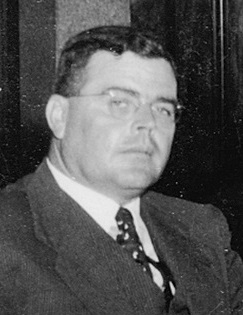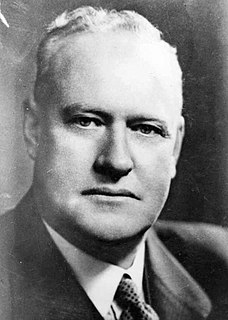
The 1950 United Kingdom general election was the first general election ever to be held after a full term of Labour government. The election was held on Thursday 23 February 1950. Despite polling over 700,000 votes more than the Conservatives, and receiving more votes than they had during the 1945 general election, Labour obtained a slim majority of just five seats—a stark contrast to 1945, when they had achieved a comfortable 146-seat majority. There was a national swing towards the Conservatives, whose performance in terms of popular vote was dramatically better than in 1945. Labour called another general election in 1951.

The 1924 United Kingdom general election was held on Wednesday 29 October 1924, as a result of the defeat of the Labour minority government, led by Ramsay MacDonald, in the House of Commons on a motion of no confidence. It was the third general election to be held in less than two years.

The 1917 Canadian federal election was held on December 17, 1917, to elect members of the House of Commons of Canada of the 13th Parliament of Canada. Described by historian Michael Bliss as the "most bitter election in Canadian history", it was fought mainly over the issue of conscription. The election resulted in Prime Minister Sir Robert Borden's Unionist government elected with a strong majority and the largest percentage of the popular vote for any party in Canadian history.

Presidential elections were held in Chile on 22 October 1925. They were the first direct elections in the country's history and the first to be held under the new 1925 constitution. The result was a victory for Emiliano Figueroa, who received 71% of the vote.
Pembrokeshire was a parliamentary constituency based on the county of Pembrokeshire in Wales. It returned one Member of Parliament (MP) to the House of Commons of the Parliament of the United Kingdom, elected by the first past the post system.

Federal elections were held in Australia on 10 December 1955. All 122 seats in the House of Representatives and 30 of the 60 seats in the Senate were up for election. An early election was called to bring the House and Senate elections back in line; the previous election in 1954 had been House-only. The incumbent Liberal–Country coalition led by Prime Minister Robert Menzies increased its majority over the opposition Labor Party, led by H. V. Evatt.

Federal elections were held in Australia on 28 September 1946. All 74 seats in the House of Representatives and 19 of the 36 seats in the Senate were up for election. The incumbent Labor Party led by Prime Minister Ben Chifley defeated the opposition Liberal–Country coalition, led by Robert Menzies. It was the Liberal Party's first federal election since its creation.
Elections were held in the state of Western Australia on 19 February 1983 to elect all 57 members to the Legislative Assembly and 18 members to the 34-seat Legislative Council.
This is a list of members of the Australian Senate from 1968 to 1971. Half of its members were elected at the 5 December 1964 half Senate election and had terms due to finish on 30 June 1971; the other half were elected at 25 November 1967 half Senate election and had terms due to finish on 30 June 1974. The process for filling casual vacancies was complex. While senators were elected for a six year term, people appointed to a casual vacancy only held office until the earlier of the next election for the House of Representatives or the Senate.

State elections were held in South Australia on 26 March 1927. All 46 seats in the South Australian House of Assembly were up for election. The incumbent Australian Labor Party government led by Premier of South Australia Lionel Hill was defeated by the opposition Liberal Federation led by Leader of the Opposition Richard L. Butler, and the Country Party (SA) led by Archie Cameron. Each district elected multiple members, with voters casting multiple votes.
This is a list of members of the 15th Legislative Assembly of Queensland from 1904 to 1907, as elected at the 1904 state election held on 27 August 1904.
This is a list of members of the 20th Legislative Assembly of Queensland from 1915 to 1918, as elected at the 1915 state election held on 22 May 1915.
This is a list of members of the 18th Legislative Assembly of Queensland from 1909 to 1912, as elected at the 1909 state election held on 2 October 1909.

Elections were held in the Australian state of Queensland on 1 June 1963 to elect the 78 members of the state's Legislative Assembly.

The 1950 New South Wales state election was held on 17 June 1950. It was conducted in single member constituencies with compulsory preferential voting and was held on boundaries created at a 1949 redistribution. The election was for all of the 94 seats in the Legislative Assembly, which was an increase of 4 seats since the previous election.

The 2007 Pendle Borough Council election took place on 3 May 2007 to elect members of Pendle Borough Council in Lancashire, England. One third of the council was up for election and the Liberal Democrats stayed in overall control of the council.

Elections were held in the Australian state of Queensland on 28 May 1966 to elect the 78 members of the Legislative Assembly of Queensland.

General elections were held in Turkey in 1931. The Republican People's Party was the only party in the country at the time, as the Liberal Republican Party that had been set up the previous year had already been dissolved. Voter turnout was reported to be 88%.

Following is a table of United States presidential elections in Tennessee, ordered by year. Since its admission to statehood in 1796, Tennessee has participated in every U.S. presidential election except the election of 1864, during the American Civil War. At that time, Tennessee was controlled by the Union and held elections, but electors were not ultimately counted.















